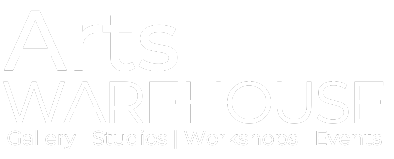By John Thomason – August 31st, 2018
(Lead image, “Look Up,” by Reed Dixon)
With a wit as droll as it is accurate, artist Toby Gotesman Schneier named one of her paintings “Another Statement on Society.” On display now at Arts Warehouse, it’s a rough-hewn observation of a couple of guys enraptured by their cellphones. It hangs next to Schneier’s similar “Girl Society,” which tracks three young women ignoring each other for the comforting balm of their iPhone screens.

These are the slice-of-life portraits of the 21stcentury: subjects with downcast gazes, cut off from the world and each other, in religious throng to the lightweight bricks that contain and disseminate their identities. Scheier’s paintings are among the more literal meditations on the tense, mutating relationship between art and social media that is at the core of Arts Warehouse’s latest exhibition, “Social Code.” Expertly curated by Nichole Hickey, of the Cultural Council of Palm Beach County, “Social Code” attempts to square the elite, rarefied, time-honored traditions of the art world with the populist, egalitarian, instantaneous gratification of social media.
The war between art and social media affects art’s patrons as well as its creators: Pictures of art flood social media, but are they replacing attendance at museums? Or, as Hickey ponders in her introductory statement, “can an Instagram feed be a curated gallery?”
Judging by the nearly 30 artists selected for “Social Code,” the dramatic shifts in art making and receiving that have been shepherded by the internet are not changes to be despaired. They are to be embraced as much as critiqued. They are to be explored, analyzed and, yes, shared and tweeted.
Some artists, like Jonathan James of wasteofpaint.org, solely work and sell on Instagram, bypassing the gatekeepers of the art world. Social posts and “art” become one and the same. Others deploy digital data as collected material, repurposing it in fresh contexts. Rora Blue’s brilliant and painful “The Unsent Project” is a voyeuristic compilation of unsent texts, usually from ex-lovers, capturing the writers at their most vulnerable.
Taber Szuluki’s “100 Days of Instagram” is just that: a series of 100 identically framed photographs culled from ‘Gram. Your eyes pan across them as if on a webpage, capturing an artistic cross-section of what humans find interesting—beaches and birds and Buddhas and breasts. Epiphany Knedler makes few distinctions between her social-media activism and her art-making. Her selections, “Church” and “Pam & June,” are simply blown-up posts from her Instagram page highlighting income inequality in her native Greenville, South Carolina. Such works disarm arguments about the difference between the old guard of vetted artists and the young turks posting their creations at breakneck speed. These Instagram posts now hang in a gallery; therefore, they have become art, as hallowed as anything else with a wall plaque and a price tag.
But more often than not, a tone of bemused detachment greets artists, like Scheier, who comment on the social-media revolution through analog means. Many of the exhibition’s artists immortalize the instantaneousness of the internet through the glacial slowness of more conventional art-making. Such is the case with Judy Polstra’s “Confessions, parables and what I’ve learned,” in which the artist painstakingly sewed communiqués fit for Facebook into her grandmother’s unfinished quilt—confessionals such as “My mother whipped me with a belt” and “Depression is not a character flaw.” Leah Freeman likewise creates time-consuming paintings that resemble hastily constructed internet memes, and the results are clever, poignant and self-effacing.
If there’s an overarching theme among the exhibition’s social-media critics, it’s that, despite the abundance and ease of social media, it has made communication more, not less, challenging. Because of their impersonality, Twitter, Instagram, Facebook, and even emails and texts are subject to mixed signals and mangled interpretations. This critique is at the heart of works as varied as Karen H. Salup’s abstract painting “Mixed Messages” and Cherie Saleeby’s “The Web We Weave and the Shadows We Leave,” a site-specific, modern-art assemblage of jumbled wires dangling from the ceiling.
This is also the subtext of Sonya Sanchez Aria’s “Lost in Translation,” a mixed-media assemblage of a hand clutching antiquated paper and quill pens, with typewriter keys joining bunched-up paper on the ground next to it. Alongside it, a bird, likely symbolizing Twitter, nestles.

Aria underlines the chasm between old and new media more directly in “Bird on a Wire,” which won this exhibition’s Best in Show. In it, the official Twitter symbol intercepts a communication between two tin cans. Various quips and interjections (“I’m not childish, you’re just a big doody head,” reads one), supplied by viewers of this exhibition from provided packets of stickers, dance on the wall around the sculpture.
These are just a few highlights in an exhibition in which nearly every work is a provocative and/or humorous and/or disquieting stunner. I’ve yet to mention Sarey Ruden’s intricate digital illustrations—feminist fantasias inspired by dismissive text messages from her online-dating misadventures. Or E.C. Ellinghausen’s Frankincams—mad-scientist assemblages of cameras and other tchotchkes that resemble Joseph Cornell contraptions updated for the surveillance state. Or Tricia Cooke’s “Vanity,” a contorted, scrappily stitched hot-pink bathroom vanity designed for unorthodox selfies.
It’s all great, and it paints a picture of a community of artists adapting, however begrudgingly, questioningly or exuberantly, into the new media age. Visit before this smart and timely exhibition closes. And tweet about it, won’t you?
“Social Code” runs through Sept. 29 at Arts Warehouse, 313 N.E. Third St., Delray Beach. Admission is free. Call 561/330-9614 or visit artswarehouse.org.




